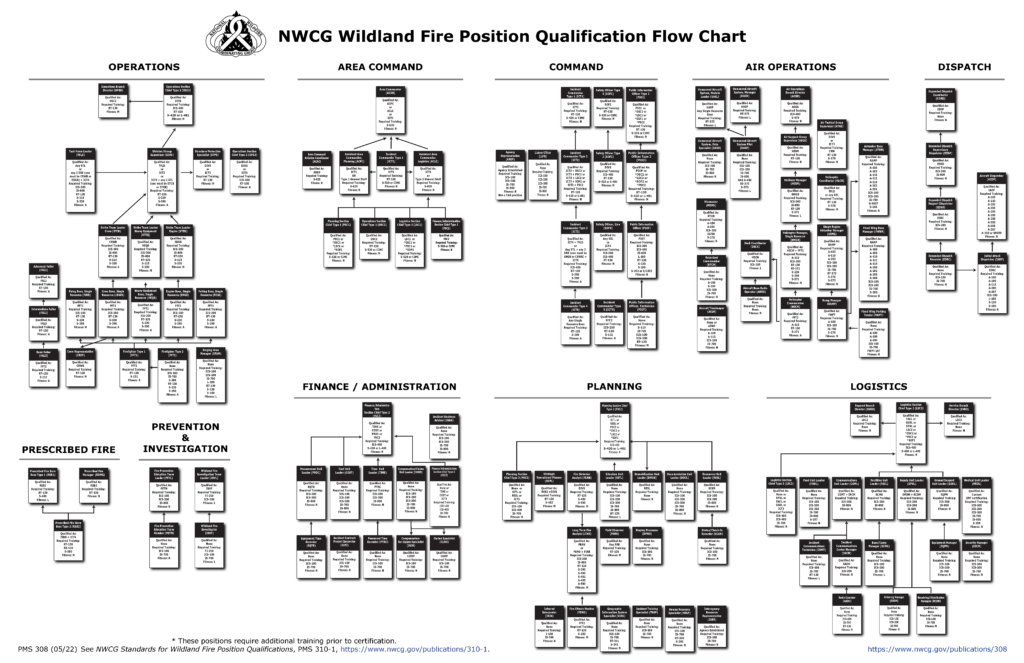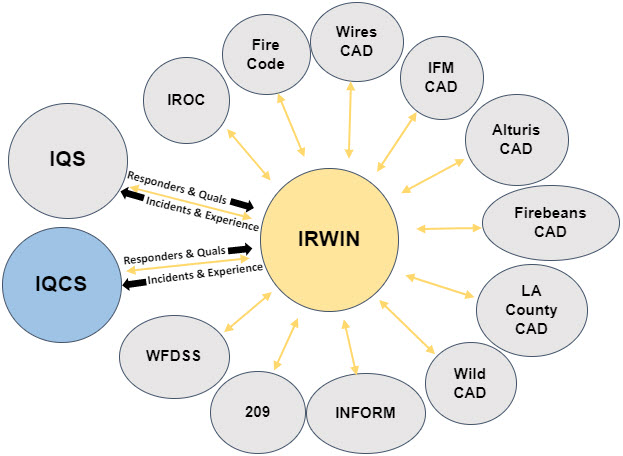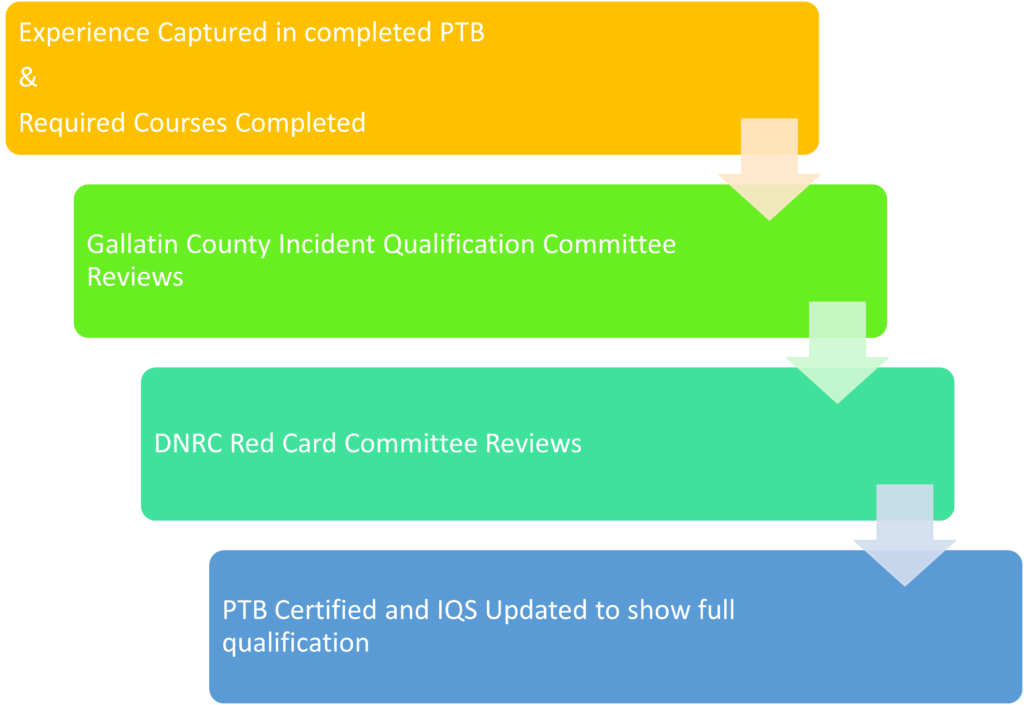Local Government Wildfire System Information for Gallatin County Resources
This page provides a central location for resources and information for mobilization of wildland fire resources from Gallatin County local government agencies.
Qualifications
Local government personnel must meet the position qualifications contained in PMS 310-1. PMS 310-1 is no longer a single published document, but now an online portal with a page for each position (position work flow). Documentation by an agency of their agency’s personnel meeting this proficiency and criteria can be obtained through 3 processes.
 Chief’s Certification: The fire chief of an agency annually certifies his personnel meet the interagency standards. This is only available for FFT2, FFT1, ENGB, ENOP and WTOP positions. All other positions must be obtained through the Position Task Book process. Local Government can not issue their own Incident Qualification Cards (Red Cards) for wildland fire for use outside of their own jurisdiction.
Chief’s Certification: The fire chief of an agency annually certifies his personnel meet the interagency standards. This is only available for FFT2, FFT1, ENGB, ENOP and WTOP positions. All other positions must be obtained through the Position Task Book process. Local Government can not issue their own Incident Qualification Cards (Red Cards) for wildland fire for use outside of their own jurisdiction.- Position Task Book: Position Task Books (PTB) are issued by Montana DNRC based on the criteria in PMS 310-1. Individuals then work as a trainee in the position the PTB is issued for under the direction of an individual qualified in that position. Evaluations in PTBs must be completed by an individual qualified in the position. Upon completion, the PTB is reviewed by the Gallatin County Incident QualificationCommittee to ensure PMS 310-1 (experience and training courses) criteria is met and provide an recommendation to the DNRC. The DNRC is the certifying agency for Incident Qualification Cards for local government in Montana.
- Recognition of Prior Learning (RPL): The RPL processes dovetails with the PTB process. RPL allows individuals to obtain credit for previous relevant experience for a position without needing to demonstrate it again in a PTB. Rarely is an individual able to completely bypass going out as a trainee with a PTB through the RPL process, but it can expedite the process. To participate in RPL an individual contacts Gallatin County Emergency Management to obtain the packet and start building their documentation packet for submission to DNRC.
Forms for a Chief’s Certification can be obtained from the DNRC Fire Business Website under LGFF Forms. Guidance for local government on qualifications is available in the Mobilization of Local Government Forces and Chapter 50 Supplement documents, both on the DNRC Fire Business Website under Agreements, Plans and Guides, then Mobilization Guides.
Incident Qualification Cards
Qualified positions are documented on an Incident Qualification Card (aka Red Card) which is automatically generated from the Incident Qualification System software based on the entered information. Only Montana DNRC can issue Incident Qualification Cards for wildland positions to local government in Montana per the Northern Rockies Master Agreement.
Agreements
In order to receive compensation for your personnel or equipment, agreements need to be in place. This will typically consist of several agreements, one for personnel and one for equipment.
Equipment
Local government equipment in Montana can be compensated in 3 methods.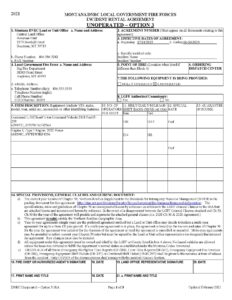
- Option 1 (Unoperated/ Dry): In an Option 1 scenario, the equipment is paid for separate from the personnel staffing it. The department gets paid for the equipment at an unoperated rate (aka Dry) and the firefighters are hired by Montana DNRC as Emergency Fire Fighters (EFF).
- Option 2 (Fully Operated/ Wet): In an Option 2 scenario, everything is paid as a package (aka Wet) to the department. The hourly rate is the Option 1 rate plus the EFF hourly rates for the firefighters, the people and equipment are not split out.
- Option 3: In an Option 3 setup, the equipment and personnel are paid for separately (but the personnel are employees of the department). The department is paid for the engine at the unoperated rate and reimbursed for their personnel costs at their regular department rates. This is typically utilized by departments with paid fire fighters.
Incident Rental Agreements (IRA) need to be established for whichever one of these your agency will be utilizing. Each unique IRA is located on the DNRC Fire Business webpage under Incident Rental Agreement (IRA) Templates. This must be completed annually with the DNRC Bozeman Unit.
Personnel
Personnel can be compensated in two ways with local government in Montana.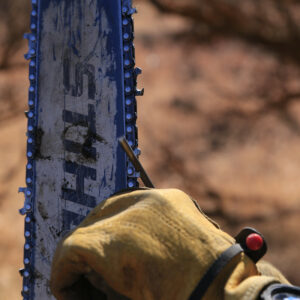
- Emergency Fire Fighter (EFF): Emergency Fire Fighters are temporary employees hired by Montana DNRC to support fire operations. Typically volunteer firefighters who’s department does not have a mechanism to payroll them are hired this way. EFF’s must work with the DNRC Bozeman Unit to complete a hiring packet annually. This process is a completely automated online process.
- Cooperative Fire Support Agreement (Option 3): Departments are reimbursed for their personnel costs. The firefighters remain employees of their department and the department is reimbursed at their incurred cost. This is the accompanying agreement to the “Option 3” for equipment.
Emergency Firefighter paperwork is located on the DNRC Fire Business webpage under Forms and Information. An access code is required and must be coordinated with the DNRC Bozeman Unit.
Cooperative Fire Support Agreement information is available on the DNRC Fire Business webpage under the Local Government Fire Forces (LGFF) section at the bottom.
Training
Where to Find It
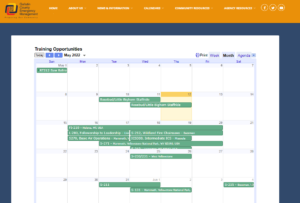 The basic building block course for wildland firefighting in Montana is the DNRC Basic Wildland Course. This course is a recognized equivalent that encompasses S-130, S-190, L-180 and ICS 100. The course is 16 hours of classroom with hands on tasks to be accomplished with your department on your equipment. This course is held annually in the Spring in Gallatin County and many other locations.
The basic building block course for wildland firefighting in Montana is the DNRC Basic Wildland Course. This course is a recognized equivalent that encompasses S-130, S-190, L-180 and ICS 100. The course is 16 hours of classroom with hands on tasks to be accomplished with your department on your equipment. This course is held annually in the Spring in Gallatin County and many other locations.
Other wildland courses can sometimes be challenging to locate as there is not a central location that they are listed. Gallatin County Emergency Management attempts to list applicable courses in the area on our training calendar. Ultimately, if you are looking for a certain course, contact Emergency Management and we’ll help you locate one.
Holding a Course
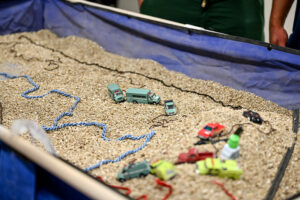 The criteria for holding a recognized NWCG training course is maintained in the Standards for Course Delivery, PMS 901-1 (aka Field Managers Course Guide). This is no longer a single document, but now an online web portal with a page for each course. Each course page will list the target positions the course supports, perquisite requirements, course hours, if it can be held locally, and minimum instructor requirements. The Course Materials tab contains the course materials such as presentations, workbooks and other supporting materials. Material for most courses are now downloadable.
The criteria for holding a recognized NWCG training course is maintained in the Standards for Course Delivery, PMS 901-1 (aka Field Managers Course Guide). This is no longer a single document, but now an online web portal with a page for each course. Each course page will list the target positions the course supports, perquisite requirements, course hours, if it can be held locally, and minimum instructor requirements. The Course Materials tab contains the course materials such as presentations, workbooks and other supporting materials. Material for most courses are now downloadable.
Course needs and schedules for Gallatin County are coordinated with the South Central Zone each fall. If you have a particular course need, please let Gallatin County Emergency Management know.
If you meet the criteria in PMS 901-1, you can hold the course and issue certificates.
Refresher Training
Wildland Fire Safety Training Annual Refresher, RT-130 (WFSTAR) is required annually for most wildland positions. This includes the classroom and fire shelter deployment portions. There is a lot of flexibility on the exact topics presented as long as the core components are met. Each each a variety of available topics are made available.
Rosters for completed refresher training must be provided annually to Gallatin County Emergency Management for entry into IQS in order to generate Incident Qualification Cards.
Work Capacity Test
A Work Capacity Test (aka Pack Test) is required annually for many positions. Administration of a Work Capacity Test is governed by the Work Capacity Test Administrator’s Guide, PMS 307. Documentation of a Work Capacity Test must be submitted to Gallatin County Emergency Management annually on the WCT Administration Form for entry into IQS in order to generate an Incident Qualification Card.
Training Documentation
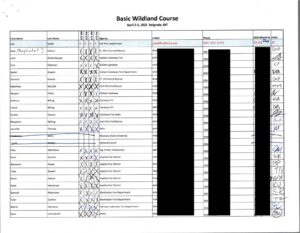 Training documentation is critical in the interagency wildland world to ensure the student get’s credit today and they retain it in the future.
Training documentation is critical in the interagency wildland world to ensure the student get’s credit today and they retain it in the future.
First, each student needs a recognized certificate for completing the course. The students should ensure their training officer gets a copy of it and that they permanently retain the original (no one wants to retake a class). If the course was hosted by a federal agency, you will likely also receive a Completion Memo. Keep a copy of that memo in your permanent record.
Secondly, every student needs to be captured on the course roster. The host agency is responsible for keeping that course roster (and any test results) according to record retention laws. More importantly, this is used to enter the course into the Incident Qualification System (IQS) software. IQS is the software that Montana uses for tracking training, incident experience and qualifications. It is Montana’s master record and qualifications are generated based on the information entered into it. Federal land management agencies use a similar system called Incident Qualifications and Certification System (IQCS) for federal employees.
Gallatin County Emergency Management maintains IQS data and master training records for local government located in Gallatin County. Montana DNRC then issues certifications from the entered data. Digital version of all course rosters and certificates should be sent to Gallatin County Emergency Management for entry into IQS.
Incident Qualification System software
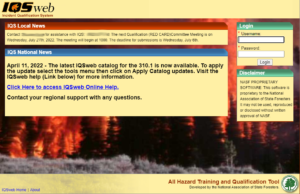 Incident Qualification System is a software platform created by the National Association of State Foresters for use by states in managing training and qualifications. Like many states, this is the platform adopted by Montana DNRC for state and local government personnel and operates it’s own state instance of the system. While similar sounding, this is completely different and separate from the Incident Qualifications and Certification System utilized by the federal land management agencies.
Incident Qualification System is a software platform created by the National Association of State Foresters for use by states in managing training and qualifications. Like many states, this is the platform adopted by Montana DNRC for state and local government personnel and operates it’s own state instance of the system. While similar sounding, this is completely different and separate from the Incident Qualifications and Certification System utilized by the federal land management agencies.
Gallatin County Emergency Management has entered into an agreement with DNRC to manage the IQS data for local government personnel within Gallatin County. Gallatin County Emergency Management is the collector and data manager of the data (and associated documentation) while the DNRC is still the certifier in the system.
How IQS Works
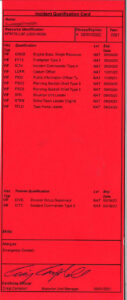 IQS is built around a profile for each individual. To create a profile, their name, affiliated agency, mailing address, email, phone and month & day of DOB is needed.
IQS is built around a profile for each individual. To create a profile, their name, affiliated agency, mailing address, email, phone and month & day of DOB is needed.
Once a profile is created, training courses (including refresher training), work capacity tests, and position task books can be entered. Based on this supporting information being entered, qualifications are automatically generated on the Incident Qualification Card. For example:
- Bob has the required classes for Striketeam Leader, has a current refresher and pack test, is currently an ENGB, and a STEN PTB has been entered. Then a Strike Team Leader Engine Trainee qualification will automatically be generated on his Incident Qualification Card.
- Bob has a good summer and is able to complete his Position Task Book for STEN. He submits it to the Gallatin County Red Card Committee who endorses it and the DNRC concurs. The PTB is changed to completed in IQS and his Incident Qualification Card is automatically changed to him being a fully qualified STEN.
- Bob gets promoted and can’t get out as a STEN for the next 5 years. After the incident proficiency time period passes, his STEN qualification will automatically be removed from his Incident Qualification Card as expired.
How does the IQS interface to other systems work
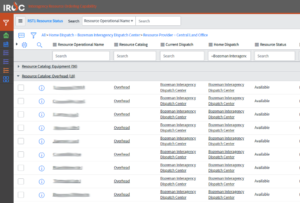 IQS is one of many software platforms that interact with each other to share critical information. Montana’s IQS software is connected to a system called Incident Reporting of Wildland-Fire Information (IRWIN). IRWIN interconnects a lot of systems and in IQS’s case, it connects Montana’s IQS to the Incident Resource Ordering Capability (IROC) dispatch software. IROC is the dispatch software utilized in the interagency wildland system. When a qualification is created in IQS, that gets pushed immediately to IQS. Conversely, if a qualification is removed in IROC, it is immediately removed from IROC.
IQS is one of many software platforms that interact with each other to share critical information. Montana’s IQS software is connected to a system called Incident Reporting of Wildland-Fire Information (IRWIN). IRWIN interconnects a lot of systems and in IQS’s case, it connects Montana’s IQS to the Incident Resource Ordering Capability (IROC) dispatch software. IROC is the dispatch software utilized in the interagency wildland system. When a qualification is created in IQS, that gets pushed immediately to IQS. Conversely, if a qualification is removed in IROC, it is immediately removed from IROC.
IROC also pushes incident experience information back to IQS. So in Bob’s case, if he had gone out as a STEN with a resource order within 5 years, that assignment would automatically be entered into Bob’s IQS record and his currency date reset to 5 years from the end of that assignment. Sometimes assignments do not get captured automatically due to a lack of a resource order, being ordered as something different than you actually did, etc… This experience will then have to be manually entered into IQS.
How do I capture records from elsewhere
If you had previous wildland experience with a federal agency (IQCS), or another state (IQS), that information can be imported into Montana’s IQS software. Please contact Gallatin County Emergency Management for help with this.
Gallatin County Incident Qualification Committee
In 2020 the Gallatin County Incident Qualification Committee was formed to support the increase of local agencies participating in wildland fire deployments. The Committee’s goal is to support our local firefighters with navigating the process successfully and ensure complete packages are handed off the the DNRC Red Card Committee. While the Gallatin County Incident Qualification Committee is not the final review body, the members are able to ensure the package is complete and add supplemental supporting information that we have from local knowledge. A recommendation, with supplemental information, is then attached to each packet and passed off to the DNRC Red Card Committee.
The Gallatin County Incident Qualification Committee typically meets in the fall to review completed PTBs and communicates about issuance of new PTBs in the spring. The Gallatin County Incident Qualification Committee consists of:
- Gallatin County Fire Council Chair
- DNRC CLO Fire Program
- Gallatin County Fire Warden
- Representatives from three fire departments
Resources
- DNRC Templates, Forms and other Paperwork for Local Government
- DNRC Mobilization Guides for Local Government (Mobilization of Local Government Forces & Chapter 50 Supplement)
- Emergency Fire Fighter Forms
- NWCG Standards for Wildland Fire Position Qualifications, PMS 310-1
- NWCG Standards for Course Delivery, PMS 901-1
- Recognition of Prior Learning Documents
- Wildland Fire Learning Portal
- Gallatin County Training Calendar
- DNRC Basic Wildland Training Curriculum
Support
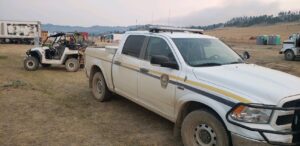 There are a lot of pieces to operating in the interagency wildland system. It can be a lot to figure out and navigate, especially if you are just starting.
There are a lot of pieces to operating in the interagency wildland system. It can be a lot to figure out and navigate, especially if you are just starting.
In cooperation with Montana DNRC, Gallatin County has a seasonal Wildfire Battalion Chief to support wildfire operations in Gallatin County. You can contact the Wildfire Battalion Chief at (406) 548-0111 or wildfire@readygallatin.com.

